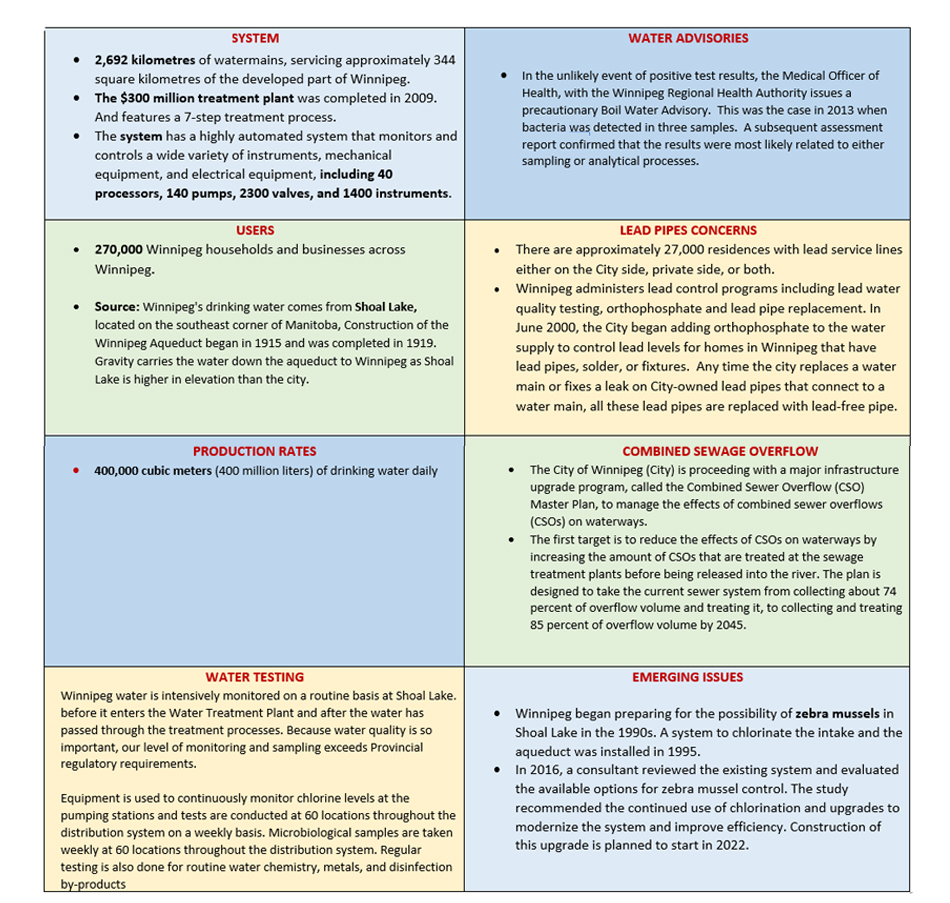2022/4/19
brought to you in part by

WINNIPEG DRINKING WATER
OVERVIEW

We sent Winnipeg media, a series of email questions. The answers are below
WT: Can you describe the drinking water system in Winnipeg, (distribution watermains, treatment plant, users, etc.) and the main challenges it faces?
The City of Winnipeg water treatment plant is a state-of-the-art, modern facility designed for performance, safety, and environmental sustainability. We started building the water treatment plant in early 2005 and finished in late 2009. The cost to build was about $300 million.
Winnipeg's water distribution system is the most expansive and expensive part of the waterworks system. It services approximately 344 square kilometres (133 square miles) of the developed part of Winnipeg.
Since its completion in 1919, the aqueduct has provided a reliable water supply, and Winnipeg's waterworks system has expanded to deliver an average of 225 million litres of water to approximately 270,000 Winnipeg households and businesses across Winnipeg.
The distribution system has several parts: branch aqueducts, feeder mains, water mains and customer connections.
Every year, the City replaces an average of 12 kilometers of water mains as part of the annual water main renewal program. In 2022, the City will spend approximately $18.5 million on the water main renewal program. Over the past 10 years, we have spent between $15 and $19 million per year to replace water mains and associated components (e.g. hydrants).
More information onWinnipeg’s water treatment plant
More information on
Winnipeg’s water distribution
The City of Winnipeg is investing approximately $18.5 million a year in water main renewals
WT: What is the source of drinking water?
Winnipeg's drinking water comes from Shoal Lake, which is part of the Lake of the Woods. It is a large, isolated lake in the southeast corner of Manitoba, at the Manitoba-Ontario border.
Construction of the Winnipeg Aqueduct began in 1915 and was completed in 1919. The aqueduct is a noted engineering marvel, patterned after ancient stone/masonry architecture with a dish-shaped concrete floor and a parabolic-shaped shell to cover and protect the water from freezing in winter. Gravity carries the water down the aqueduct to Winnipeg as Shoal Lake is higher in elevation than the city.
More Information on Winnipeg’s source of drinkin water
WT: Do the plants have any treatment for emerging contaminants such as PFAS, and endocrine disrupters?
Winnipeg’s water treatment plant does not have processes that were designed specifically for dealing with emerging contaminants. Our current processes would have removal potential depending on the containment. The need to assess or supplement our processes will be examined as new information on the emerging contaminants is received.
Note that testing for endocrine disrupters on our treated water has been performed and none have been detected. Winnipeg’s water source is from a protected watershed and therefore the likely hood of these types of contaminants (PFAS or endocrine disrupters) being present in our raw water source is very low.
WT: With the increase in extreme weather events and flooding, what measures is Winnipeg taking to protect its plants?
A capital project to improve flood protection measures at Winnipeg’s water treatment plant is currently in the design phase. Our water treatment plant and sewage treatment plants have all been built to industry standards. about how Winnipeg is protected from river flooding.
WT: Combined sewage overflows are a common problem in cities across Canada. What is the situation in Winnipeg? What was the amount of CSO in recent years?
About a third of the City's sewer system contains combined sewers. Typically, they were built before the 1960s and serve older areas of the city. Every time there is a CSO, there is a temporary discharge to the river of bacteria, floating debris, and organic material (nutrients). By reducing CSOs, we can do our part to help protect the health of our rivers and lakes.
Information on the City of Winnipeg Combined Sewer System and Combined Sewer Overflows
WT: Lead connections are also a common problem, how many lead connections do you estimate there are in Winnipeg? What is the city doing about it?
There are approximately 27,000 residences with lead service lines either on the City side, private side, or both. Information on lead services in Winnipeg
WT: Are there other emerging issues you are looking into?
The City of Winnipeg has plans in place to deal with zebra mussels in its drinking water source.
|